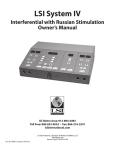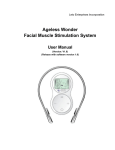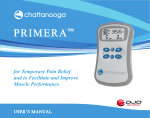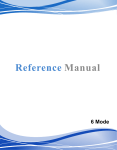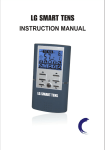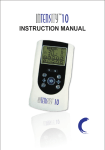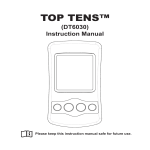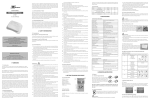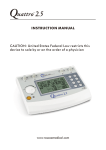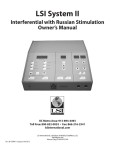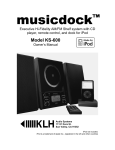Download Twin Stim Plus 3rd Edition Manual
Transcript
Twin Stim® Plus 3rd Edition Combo Stimulator INSTRUCTION MANUAL This manual is valid for the Twin Stim® Plus 3rd Edition Combo Stimulator This user manual is published by Roscoe Medical, Inc. Roscoe Medical, Inc. does not guarantee its contents and reserves the right to improve and amend it at any time without prior notice. Amendments may however be published in new editions of this manual. All Rights Reserved.Rev.V1.0 © 2013, 20130719 United States Federal Law restricts this device to sale by or on the order of a physician or licensed practitioner. Declaration of conformity: Roscoe Medical, Inc. declares that the device complies with following normative documents: IEC60601-1, IEC60601-1-2, IEC60601-1-11, IEC60601-2-10, ISO10993-1, ISO10993-5, ISO10993-10, ISO14971 2 TABLE OF CONTENTS Chapter 1: GENERAL DESCRIPTION................................................... 4 Chapter 2: INTRODUCTION........................................................................ 5 Chapter 3: IMPORTANT SAFETY INFORMATION......................... 8 Chapter 4: CONSTRUCTION....................................................................12 Chapter 5: TECHNICAL SPECIFICATIONS.......................................15 Chapter 6: THERAPY PROGRAM AND WAVEFORMS.............17 Chapter 7: UNIT AND ACCESSORIES............................................... 24 Chapter 8: OPERATING INSTRUCTIONS........................................ 25 Chapter 9: PARAMETER CONTROLS................................................ 29 Chapter 10: PATIENT COMPLIANCE METER.................................. 32 Chapter 11: MAINTENANCE AND STORAGE...................................33 Chapter 12: TROUBLESHOOTING......................................................... 34 Chapter 13: NORMALIZED SYMBOLS................................................. 36 Chapter 14: WARRANTY.............................................................................. 37 3 Chapter 1: GENERAL DESCRIPTION The Twin Stim® Plus 3rd Edition Combo Stimulator is a battery operated pulse generator that sends electrical impulses electrodes to the body and reaches the nerves and underlying muscle group. This unit is a combination stimulator of TENS, EMS, IF (Interferential) and RUSSIAN which can be used for muscle stimulation and pain relief. The device is provided with four controllable output channels, each independent of each other. An electrode pair can be connected to each output channel. The intensity level is controlled by press buttons. 4 Chapter 2: INTRODUCTION EXPLANATION OF PAIN Pain is a warning system and the body’s method of telling us that something is wrong. Pain is important; without it abnormal conditions may go undetected, causing damage or injury to vital parts of our bodies. Even though pain is a necessary warning signal of trauma or malfunction in the body, nature may have gone too far in its design. Aside from its value in diagnosis, long-lasting persistent pain serves no useful purpose. Pain does not begin until coded message travels to the brain where it is decoded, analyzed, and then reacted to. The pain message travels from the injured area along the small nerves leading to the spinal cord. Here the message is switched to different nerves that travel up the spinal cord to the brain. The pain message is then interpreted, referred back and the pain is felt. EXPLANATION OF TENS Transcutaneous Electrical Nerve Stimulation is a non-invasive, drug free method of controlling pain. TENS uses tiny electrical impulses sent through the skin to nerves to modify your pain perception. TENS does not cure any physiological problem; it only helps control the pain. TENS does not work for everyone; however, in most patients it is effective in reducing or eliminating the pain, allowing for a return to normal activity. HOW TENS WORKS There is nothing “magic” about Transcutaneous Electrical Nerve Stimulation (TENS). TENS is intended to be used to relieve pain. The TENS unit sends comfortable impulses through the skin that stimulate the nerve (or nerves) in the treatment area. In many cases, this stimulation will greatly reduce or eliminate the pain sensation the patient feels. Pain relief varies by individual patient, mode selected for therapy, and the type of pain. In many patients, the reduction or elimination of pain lasts longer than the actual period of stimulation (sometimes as much as three to four times longer). In others, pain is only modified while stimulation actually occurs. You may want to discuss this therapy option with your physician or therapist to see if it will benefit your pain management needs. 5 EXPLANATION OF EMS Electrical Muscle Stimulation is an internationally accepted and proven way of treating muscular injuries. It works by sending electronic pulses to the muscle needing treatment; this causes the muscle to exercise passively. It is a product derived from the square waveform, originally invented by John Faraday in 1831. Through the square wave pattern it is able to work directly on muscle motor neurons. The Twin Stim® Plus 3rd Edition Combo Stimulator has low frequency and this in conjunction with the square wave pattern allows direct work on muscle groupings. This is being widely used in hospitals and sports clinics for the treatment of muscular injuries and for the re-education of paralyzed muscles, to prevent atrophy in affected muscles and improving muscle tone and blood circulation. HOW EMS WORKS The EMS units send comfortable impulses through the skin that stimulate the nerves in the treatment area. When the muscle receives this signal it contracts as if the brain has sent the signal itself. As the signal strength increases, the muscle flexes as in physical exercise. Then when the pulse ceases, the muscle relaxes and the cycle starts over again, (Stimulation, Contraction and Relaxation.) Powered muscle stimulators should only be used under medical supervision for adjunctive therapy for the treatment of medical diseases and conditions. EXPLANATION OF IF (Interferential) Interferential Stimulation (IF) is an anti-inflammatory based treatment modality. Interferential stimulation is characterized by two alternatingcurrent sine waves or square waves of differing frequencies that “work” together to produce an interferential current that is also known as a beat pulse or alternating modulation frequency. One of the two currents is usually held at 4,000 Hz, and the other can be held constant or varied over a range of 4,001 to 4,150 Hz. Because of the frequency, the interferential wave meets low impedance when crossing the skin to enter deep into soft tissues. The interferential currents reportedly can stimulate sensory, motor, and pain fibers. These large impulse fibers interfere with the transmission of pain messages at the spinal cord level. This deep tissue penetration stimulates parasympathetic nerve fibers for increased blood flow and edema reduction. It utilizes the low electric-current to 6 stimulate muscle nerves to achieve the symptomatic relief of chronic intractable pain, post-traumatic pain, and post-surgical pain. EXPLANATION OF RUSSIAN Russian stimulation uses medium frequencies to provide electrical stimulation to muscle groups and is used to reduce muscle spasms as well as for muscle strengthening. Russian stimulation is a specific form of electro-stimulation with a Symmetrical Biphasic Square waveform produced by dividing a 2500Hz carrier frequency into 20~80Hz packets. This method was claimed by its author (Kots) to produce maximal muscle strengthening effects without significant discomfort to the patient. INDICATION FOR USE For TENS and IF (Interferential): ► Symptomatic relief of chronic intractable pain; ► Reduction of inflammation; ► Post-traumatic acute pain and edema; ► Post-surgical acute pain and edema. For EMS and Russian: ► Relaxation of Muscle spasms and edema reduction; ► Prevention or retardation of disuse atrophy; ► Increasing local blood circulation; ► Muscle re-education; ► Maintaining or increasing range of motion; ► Immediate postsurgical stimulation of calf muscles to prevent venous thrombosis. 7 Chapter 3: IMPORTANT SAFETY INFORMATION Read instruction manual before operation. Be sure to comply with all “Contraindications”, “Warnings”, “Cautions” and “Adverse reactions” in the manual. Failure to follow instructions can cause harm to user or device. 3.1 Contraindications 1) This device should not be used for symptomatic local pain relief unless etiology is established or unless a pain syndrome has been diagnosed. 2) This device should not be used when cancerous lesions are present in the treatment area. 3) Stimulation should not be applied over swollen, infected, inflamed areas or skin eruptions (e.g. phlebitis, thrombophlebitis, varicose veins, etc.). 4) Electrodes must not be applied to sites that might cause current/ stimulation to flow through the carotid sinus region (anterior neck) or trans-cerebrally (through the head). 5) Do not use this device if the patient has a demand-type cardiac pacemaker or any implanted defibrillator. 6) This device should not be used over poorly enervated areas. 7) This device should not be used on patients with epilepsy. 8) This device should not be used on patients with serious arterial circulatory problems in the lower limbs. 9) This device should not be used on patients with abdominal or inguinal hernia. 10) Do not use this device if you have heart disease without consulting your physician. 3.2 Warnings, cautions and adverse reactions Warnings 1) 2) This device should be used only under the continued supervision of a licensed physician. The long-term effects of chronic electrical stimulation are unknown. Electrical stimulation devices do not have any curative value. 8 3) 4) 5) 6) 7) 8) 9) 10) 11) 12) 13) 14) 15) 16) 17) 18) 19) 20) TENS is a symptomatic treatment and, as such, suppresses the sensation of pain, which would otherwise serve as a protective mechanism. Safety has not been established for the use of therapeutic electrical stimulation during pregnancy. Do not use during pregnancy unless directed by your physician. Electrical stimulation is not effective for pain of central origin. Electronic monitoring equipment (such as ECG monitors and ECG alarms) may not operate properly when electrical stimulation is in use. Stimulation should not be applied over the carotid sinus nerves, particularly in patients with a known sensitivity to the carotid sinus reflex. Stimulation should not be applied over the anterior neck or mouth. Severe spasm of the laryngeal and pharyngeal muscles may occur and the contractions may be strong enough to close the airway or cause difficulty in breathing. Stimulation should not be applied transthoracically in that the introduction of electrical current into the heart may cause cardiac arrhythmias. Stimulation should not take place while the user is connected to highfrequency surgical equipment, it may cause burn injuries on the skin under the electrodes, as well as problems with the stimulator. Do not use the stimulator in the vicinity of shortwave or microwave therapy equipment, since this may affect the output power of the stimulator. Never use in environments with high humidity such as in the bathroom or when having a bath or shower. Caution should be used in applying electrical stimulation to patients suspected of having heart disease. Further clinical data is needed to show there are no adverse results. Never use near the heart. Stimulation electrodes should never be placed anywhere on the front of the thorax (marked by ribs and breastbone), but above all not on the two large pectoral muscles. Here it can increase the risk of ventricular fibrillation and lead to cardiac arrest. Electrodes should not be placed over the eyes, in the mouth, near the genitals or internally. Never use on the areas of the skin which lack normal sensation. Apply the electrodes to clean, dry, and unbroken skin only. Keep electrodes separate during treatment, electrodes in contact with other could result in improper stimulation or skin burns. Keep the stimulator out of reach of children. Consult your doctor if you are in any doubt whatsoever. 9 Cautions: 1) Federal law (USA) restricts this device to sale by or on the order of a physician. 2) For single patient use only. 3) Keep yourself informed of the contraindications. 4) This stimulator is not intended for unattended, personal use by patients who have noncompliant, emotionally disturbed, dementia, or low IQ. 5) Read, understand, and practice the warnings, cautions and operating instructions. Know the limitations and hazards associated with using any device. Observe the precautionary and operational decals placed on the unit. Always follow the operating instructions prescribed by your healthcare practitioner. 6) The instruction of use was listed; any improper use may be dangerous. 7) Do not use this device for undiagnosed pain syndromes until consulting a physician. 8) Patients with an implanted electronic device, such as a cardiac pacemaker, implanted defibrillator, or any other metallic or electronic device should not use this device without first consulting a doctor. 9) Stimulation delivered by this device may be sufficient to cause electrocution. Electrical current of this magnitude must not flow through the thorax or across the chest because it may cause a cardiac arrhythmia. 10) Do not place electrodes on the front of the throat as spasm of the Laryngeal and Pharyngeal muscle may occur. Stimulation over the carotid sinus (neck region) may close the airways, make breathing difficult, and may have adverse effects on the heart rhythm or blood pressure. 11) Do not place electrodes on your head or at any sites that may cause the electrical current to flow trans-cerebrally (through the head). 12) Patients with heart disease, epilepsy, cancer or any other health condition should not use this device without first consulting a physician. 13) Some patients may experience skin irritation or hypersensitivity due to the electrical stimulation or silicone rubber. If rash develops or pain persists, discontinue use and consult a doctor. 14) Electrode placement and stimulation settings should be based on the guidance of prescribing practitioner. 15) Effectiveness is highly dependent upon patient selection by a person qualified in the management of pain afflicted patients. 10 16) Isolated cases of skin irritation may occur at the site of the electrode placement following long-term application. If this occurs, discontinue use and consult your physician. 17) The electrodes are only to be placed on healthy skin. Avoid skin irritation by ensuring that good contact is achieved between electrodes and skin. 18) If the stimulation levels are uncomfortable or become uncomfortable, reduce the stimulation Intensity to a comfortable level and contact your physician if problems persist. 19) This device should not be used while driving, operating machinery, close to water, or during any activity in which involuntary muscle contractions may put the user at undue risk of injury. 20) Never use the device in rooms where aerosols (sprays) are used or pure oxygen is being administered. 21) Do not use it near any highly flammable substances, gases or explosives. 22) Do not use this device at the same time as other equipment which sends electrical pulses to your body. 23) Do not confuse the electrode cables and contacts with your headphones or other devices, and do not connect the electrodes to other devices. 24) Do not use sharp objects such as pencil point or ballpoint pen to operate the buttons on the control panel. 25) Inspect Applicator cables and associated connectors before each use. 26) Turn the device off before applying or removing electrodes. 27) Electrical stimulators should be used only with the leads and electrodes recommended for use by the manufacturer. 28) This device has no AP/APG protection. Do not use it in the presence of explosive atmosphere and flammable mixture. Adverse reactions: Skin irritation from the electrode gel and electrode burns are potential adverse reactions. If skin irritation occurs, discontinue use and consult your physician. Note: Always use electrodes that are legally marketed and sold in the United States under 510K guidelines. 11 Chapter 4: CONSTRUCTION PANEL 1 2b 2c 2a 2d CH1 CH2 CH3 CH4 3 12 11 10 Twin Stim® Plus 3rd Edition 9 4 8 5 7 6 12 13 14 15 Model: Twin Stim® Plus 3rd Edition Combo Stimulator Supply Voltage: DC 9V/0.8A adaptor or 4XAA 1.5V batteries Caution: Federal law (USA) restricts this device to sale by or on the order of a physician Manufacturer for Roscoe Medical, Inc. 21973 Commerce Parkway, Strongsville, Ohio 44149 www.roscoemedical.com 1) 2) 3) 4) 5) 6) 7) 8) 9) Lead connector Channel 1, Channel 2, Channel 3 and Channel 4 Liquid crystal display Panel cover Mode control Power on/off control AC Adapter Set control Increment control – for Pulse Rate, Pulse Width and time indicators, interference frequency 10) Decrement control – for Pulse Rate, Pulse Width and time indicators, interference frequency 11) Intensity decrease control 12) Intensity increase control 13) Belt clip 14) Battery case 15) Battery cover 13 LCD 1 6 2 3 7 4 5 8 1) Output intensity from channel 1 to channel 4 2) TENS, EMS, IF (Interferential) and RUSS (Russian) mode 3) Therapy program 4) Time symbol 5) Pulse rate and pulse width indicator 6) Lock symbol 7) Low battery symbol 8) Time indicator 14 Chapter 5: TECHNICAL SPECIFICATIONS The technical specification details of Twin Stim® Plus 3rd Edition Combo stimulator are as follows: No. MECHANISM TECHNICAL DESCRIPTION 01 Channel Four, isolated between channels 02 Type of protection against electric shock Class II Equipment 03 Output intensity 0~40Vpp (at 500 ohm load) 04 Waveform Bi-Phasic Square Pulse 05 Power source DC 6V, 4×AA 1.5V battery, or AC Adapter output :DC 9V,800mA 06 Size 13.8cm(L)x7.8cm(W)x2.8cm(H) 07 Weight 425 grams with battery. 08 Pulse Rate TENS/EMS: 2Hz~150Hz; IF: 4000Hz~4150 Hz ; RUSS: fixed rate:2500 Hz; Burst rate:20Hz~80Hz 09 Pulse width 50μs~300μs 10 On Time Adjustable, 2~90 seconds,1Sec./step 11 Off Time Adjustable, 0~90 seconds,1Sec./step 12 Ramp Time Adjustable, 1~8 seconds, 1 Sec./ step, The “On” time will increase and decrease in the setting value. 15 Two adjustable timers, from 1 to 60 minutes or Continuous. Adjustable in 1 minute each step from 1 to 15 minutes, and 5 minutes each step from 15 to 60 minutes. Treatment time countdown automatically. 13 Treatment time 14 Patient Compliance This unit can store 60 sets of operation records. Meter Total recorded time is 999 hours. 15 Low battery symbol A low battery symbol will show up when the battery is low. 16 Operating conditions Temperature: 0°C ~40°C Relative Humidity: 30%~75% Atmosphere Pressure: 700hPa~1060hPa 17 Temperature:-10°C~50°C Storage conditions Relative humidity:10%~90% Atmospheric pressure: 700hPa ~ 1060hPa 16 Chapter 6: THERAPY PROGRAM AND WAVEFORMS TENS PROGRAM No. MECHANISM TECHNICAL DESCRIPTION 01 Program Five TENS program: B(Burst), N(Normal), M(Modulation),SD1(Strength Duration 1), SD2 (Strength Duration 2) 02 Burst rate: Adjustable, 0.5 ~ 5Hz Burst program (B) Pulse width adjustable, 50~300μs Frequency fixed = 100 Hz 03 Normal program (N) The pulse rate and pulse width are adjustable. It generates continuous stimulation based on the setting value. Modulation program (M) Modulation mode is a combination of pulse rate and pulse width modulation. The pulse rate and width are automatically varied in a cycle pattern. The pulse width is decreased by 50% from its original setting in 0.5s, and then the pulse rate is decreased by 50% from its original setting in 0.5 seconds. Total cycle time is 1 second. In this mode, pulse rate (2~150Hz) and pulse width (50~300μs) are fully adjustable. Strength-Duration program (SD1) The SD1(Strength-Duration) mode consists of automatic modulation intensity and pulse width in 40% range. The intensity is always increasing while the pulse width is decreasing and viceversa. The intensity is decreased by 40% while the pulse width is increased by 40% in 5 seconds. In the next 5 seconds, the intensity is increased by 40% while the pulse width is decreased by 40%. Total cycle time is 10 04 05 17 seconds. Pulse rate (2~150Hz) and pulse width (50~300μs) are fully adjustable. 06 The SD2(Strength-Duration) mode consists of automatic modulation intensity and pulse width in 70% range. The intensity is always increasing while the pulse width is decreasing and vice-versa. The intensity is decreased by Strength-Duration 70% while the pulse width is increased by program (SD2) 70% in 5 seconds. In the next 5 seconds, the intensity is increased by 70% while the pulse width is decreased by 70%. Total cycle time is 10 seconds. Pulse rate (2~150Hz) and pulse width (50~300μs) are fully adjustable. TENS WAVEFORMS 1.Burst Burst Frequency 2. Normal 18 3. Modulation Cycle time 4. Strength-Duration EMS PROGRAM No. MECHANISM TECHNICAL DESCRIPTION 01 Program Three EMS Modes: C(Constant), S(Synchronous), A(Alternate) 02 Constant program (C) Constant stimulation based on setting value. Only pulse width, pulse rate and timer are adjustable in this mode. “Constant” is equal to the “Normal” mode in TENS. Synchronous program (S) Stimulation of both channels occurs synchronously. The “ON” time including “Ramp up” and “Ramp down” time. Therefore, the setting ON time should be no less than two times the “Ramp” time in this mode. ON time≥Ramp up + Ramp down 03 19 04 The stimulation of the CH2 will occur after the 1st contraction of CH1 is completed. In this mode, the setting of ON time should be no less than two times of the “Ramp” time. The OFF time should be equal or more than the ON time. ON time ≥Ramp up + Ramp down OFF time ≥ON time Alternate program (A) EMS WAVEFORMS Constant (C) Synchronous (S) CH1 CH2 ON TIME OFF TIME 20 Alternate (A) CH1 CH2 IF (Interferential) PROGRAM No. MECHANISM TECHNICAL DESCRIPTION 01 Program Three IF Modes: N (Normal), M (Modulation) and M1 (Modulation 1) Normal program (N) The pulse rates of the CH1 and CH3 are fixed in 4000Hz; The interference frequencies of CH2 and CH4 are adjustable from 1Hz to 150Hz. The pulse rates of CH2 and CH4 are based on the setting value and fixed frequency (4000Hz), means that pulse rate=4000Hz+Interference frequency. Modulation program (M) The pulse rates of the CH1 and CH3 is fixed in 4000Hz; The pulse rates of CH2 and CH4 are based on the interference frequencies and fixed frequency (4000Hz), means that pulse rate = 4000Hz+Interference frequency. The interference frequencies are adjustable from 1Hz to 80Hz. The pulse rates of CH2 and CH4 are modulated between setting value and 4001Hz in 10 seconds. 02 03 21 04 Modulation program (M1) The pulse rates of the CH1 and CH3 is fixed in 4000Hz; The pulse rates of CH2 and CH4 are based on the interference frequencies and fixed frequency (4000Hz), means that pulse rate = 4000Hz+Interference frequency. The interference frequencies are adjustable from 80Hz to 150Hz. The pulse rates of CH2 and CH4 are modulated between setting value and 4080Hz in 10 seconds. IF (Interferential) WAVEFORM RUSS (Russian) PROGRAM No. MECHANISM TECHNICAL DESCRIPTION 01 Program Three RUSS Modes: N (Normal), M (Modulation) and M1 (Modulation 1) 02 Normal program (N) Constant stimulation based on setting value. Burst frequency is adjustable from 20Hz to 80 Hz. The duty cycle keep at 50%. Modulation program (M) Duty cycle is automatically varied in a cycle time. The duty cycle is increase from 10% to 50% in 10 seconds, and then decrease from 50% to 10% in next 10 seconds. In this program, burst frequency is adjustable from 20Hz to 80Hz. 03 22 04 Modulation program (M1) Burst frequency is decreased from the setting value to 20Hz in 10 seconds, and then increased from 20Hz to the setting value in next 10 seconds. In this program, the burst frequency is adjustable from 20Hz to 80Hz. RUSSIAN WAVEFORM 23 Chapter 7: ACCESSORIES Twin Stim® Plus 3rd Edition Combo Stimulator comes complete with standard accessories as below: No DESCRIPTION QTY’ 1 50 X 50 mm Adhesive Electrodes 8PCS 2 Lead wires 4PCS 3 AA Battery 4PCS 4 Instruction Manual 1PC 5 Carrying Case 1PC 6 AC Adapter 1PC 24 Chapter 8: OPERATING INSTRUCTIONS 8.1 Check/Replace the batteries Over time, in order to ensure the functional safety of device, changing the batteries is necessary. 1) Slide the battery cover and open. 2) Insert four AA batteries into the battery compartment. 3) Make sure you are installing the batteries properly. Be sure to match the positive and negative ends of the battery to the marking in the battery compartment of the device. 4) Replace the battery cover and press to close. Caution: ► Remove the batteries if the device is not in use for long periods of time. ► Do not mix old and new batteries or difference type of batteries. ► Warning: If batteries leak and come into contact with the skin or eyes, wash immediately with copious amounts of water. ► Batteries must be handled by an adult. Keep batteries out of the reach of children. ► Remove exhausted batteries from the unit. ► Dispose of batteries safety according to local regulation. 8.2 Connect electrodes to lead wires Insert the lead wire connector into electrodes connector (standard 0.08 inch female connection). Make sure no bare metal of the pins is exposed. Caution: Always use the electrodes with CE mark, or which are legally marketed in the US under 510(K) procedure. 25 Connection Cables 8.3 Connect lead wires to device 1) Before proceeding to this step, be sure the device is completely turned OFF. 2) Insert the lead wires into the lead connectors on top of the device. PLUG LEAD CONECTOR Caution: Do not insert the plug of the patient lead wire into any AC power supply socket. 8.4 Electrode 8.4.1 Electrode options The electrodes are disposable and should be routinely replaced when they start to lose their adhesive nature. If you are unsure of your electrode adhesive properties, order replacement electrodes. Replacement electrodes should be re-ordered through or on the advice of your physician to ensure proper quality. Follow application procedures outlined in electrode packing, to maintain optimal stimulation and to prevent skin irritation. 8.4.2 Place electrodes on skin Apply electrodes to the exact site indicated by your physician or therapist, before applying electrodes, be sure the skin surface over which electrodes are placed is thoroughly cleaned and dried. Make sure the electrodes are placed firmly to the skin and make good contact between the skin and the electrodes. Place the electrodes over the skin; attach them properly, firmly, and evenly. Caution: 1) Before applying the self-adhesive electrodes, it is recommended to wash 26 and degrease the skin, and then dry it. 2) Do not turns on the device when the self-adhesive electrodes are not positioned on the body. 3) Never remove the self-adhesive electrodes from the skin while the device is still turned on. 4) It is recommended that, at a minimum, 4cm x 4cm self-adhering based, square electrodes are used at the treatment area. 8.4.3 Electrode placement The placement of electrodes can be one of the most important parameters in achieving success with therapy. Of utmost importance is the willingness of the physician to try the various styles of electrode placement to find which method best fits the needs of the individual patient. Every patient responds to electrical stimulation differently and their needs may vary from the conventional settings suggested here. If the initial results are not positive, speak to your physician about alternative stimulation settings and/or electrode placements. Once an acceptable placement has been achieved, mark down the electrodes sites and the settings, so the patient can easily continue treatment at home. 8.5 Turn on Before using the device for the first time, you are strongly advised to take careful note of the counter-indications and safety measures detailed at the beginning of this manual (Safety information), as this powerful equipment is neither a toy nor a gadget! Press the [ ] button to turn on the device. 8.6 Select the therapeutic mode and program There are 4 therapeutic modes available – TENS, EMS, IF and RUSS. The therapeutic mode and program can be selected by pressing the [MODE] button. The LCD displays as (TENS)→B; (TENS)→N; (TENS)→M; (TENS)→SD1; (TENS)→SD2; (EMS)→C; (EMS)→S; (EMS)→A; (IF)→N; (IF)→M; (IF)→M1; (RUSS)→N; (RUSS)→M; (RUSS)→M1. 27 8.7 Adjust output intensity There are 4 sets of intensity buttons, which correlate to each of the 4 channels. Slowly increase or decrease the intensity as directed by your physician by pressing the up or down intensity buttons under the respective channel. Press the up arrow [△] button to increase intensity and press the down arrow [▽] button to decrease intensity. Caution: If the stimulation levels are uncomfortable or become uncomfortable, reduce the stimulation intensity to a comfortable level and contact your medical practitioner if problems persist. 8.8 Turn off the device After treatment, turn the device off by pressing the [ 28 ] button. Chapter 9: PARAMETER CONTROLS There are 4 therapeutic modes available –TENS, EMS, IF and RUSS. Each mode’s parameters can be set by pressing [SET] button to enter setting mode, and then adjust the parameters by pressing [▲] or [▼] button. 9.1 Steps to set a new TENS program 9.1.1 Select TENS therapeutic mode and program Press [MODE] button until the LCD display “TENS” and expected program (B, N, M, SD1, SD2). 9.1.2 Set pulse width Press [SET] button to enter setting mode, the “Width” indicator displays on LCD, press [▲] or [▼] button to adjust the parameter from 50μs to 300μs. 9.1.3 Set pulse rate Press [SET] button again, The “Rate” indicator displays on LCD, press [▲] or [▼] button to adjust the parameter from 2Hz to 150Hz. In Burst (B) program, you can set the burst rate from 0.5Hz to 5Hz. 9.1.4 Set timer There are two adjustable timers available. The left timer controlling the treatment time of CH1 and CH2. The right timer controlling the treatment time of CH3 and CH4. The treatment time is adjustable from 1 to 60 minutes or C (Continuous). Press [SET] button to enter this menu, then press [▲] or [▼] button to adjust the setting. Press [▲] button when the timer shows 60 minutes, it will be switched to continuous stimulation. Two timers can be set in the same way. 9.2 Steps to set a new EMS program 9.2.1 Select EMS therapeutic mode and program Press [MODE] button until the LCD display “EMS” and expected program (C, S, A). 9.2.2 Set ramp time (A or S program) Press [SET] button to enter setting mode, The “Ramp” indicator displays on LCD when you select Alternate (A) or Synchronous (S) program, press 29 [▲] or [▼] button to adjust the parameter from 1s to 8s. 9.2.3 Set ON time (A or S program) Press [SET] button again, The “On” indicator displays on LCD, press [▲] or [▼] button to adjust the parameter from 2s to 90s. 9.2.4 Set OFF time (A or S program) Press [SET] button again, The “Off” indicator displays on LCD, press [▲] or [▼] button to adjust the parameter from 2s to 90s. 9.2.5 Set pulse width Press [SET] button again, the “Width” indicator displays on LCD, press [▲] or [▼] button to adjust the parameter from 50μs to 300μs. 9.2.6 Set pulse rate Press [SET] button again, The “Rate” indicator displays on LCD, press [▲] or [▼] button to adjust the parameter from 2Hz to 150Hz. 9.2.7 Set timer There are two adjustable timers available. The left timer controlling the treatment time of CH1 and CH2. The right timer controlling the treatment time of CH3 and CH4. The treatment time is adjustable from 1 to 60 minutes or C (Continuous). Press [SET] button to enter this menu, then press [▲] or [▼] button to adjust the setting. Press [▲] button when the timer shows 60 minutes, it will be switched to continuous stimulation. Two timers can be set in the same way. 9.3 Steps to set a new IF program 9.3.1 Select IF therapeutic mode and program Press [MODE] button until the LCD display “IF” and expected program (N, M, M1). 9.3.2 Set interference frequency Press [SET] button to enter setting mode, press [▲] or [▼] button to adjust the parameter from 1Hz to 150Hz. 9.3.3 Set timer There are two adjustable timers available. The left timer controlling the treatment time of CH1 and CH2. The right timer controlling the treatment time of CH3 and CH4. The treatment time is adjustable from 1 to 60 minutes 30 or C (Continuous). Press [SET] button to enter this menu, then press [▲] or [▼] button to adjust the setting. Press [▲] button when the timer shows 60 minutes, it will be switched to continuous stimulation. Two timers can be set in the same way. 9.4 Steps to set a new RUSS program 9.4.1 Select RUSS therapeutic mode and program Press [MODE] button until the LCD display “RUSS” and expected program (N, M, M1). 9.4.2 Set burst frequency Press [SET] button to enter setting mode, press [▲] or [▼] button to adjust the burst frequency from 20Hz to 80Hz. 9.4.3 Set timer There are two adjustable timers available. The left timer controlling the treatment time of CH1 and CH2. The right timer controlling the treatment time of CH3 and CH4. The treatment time is adjustable from 1 to 60 minutes or C (Continuous). Press [SET] button to enter this menu, then press [▲] or [▼] button to adjust the setting. Press [▲] button when the timer shows 60 minutes, it will be switched to continuous stimulation. Two timers can be set in the same way. 31 Chapter 10: PATIENT COMPLIANCE METER This unit can store 60 sets of operation records. Total treatment time up to 999 hours can be stored. Check & Delete Individual Record Press [MODE] button and turn on the power simultaneously. The LCD will show the number of records and operation time. Press the [▲] or [▼] button to check each record. To delete a record, press [SET] button for 3 seconds. Check & Delete Accumulative Record At the individual records menu, press [MODE] button to switch to accumulative record menu. Press the [SET] button first, then press the [MODE] button simultaneously for 3 seconds and all of the records will be deleted followed by a beeper sound. 32 Chapter 11: MAINTENANCE AND STORAGE 1) Non-flammable cleaning solution is suitable for cleaning the device. Note: Do not smoke or work with open lights (for example, candles, etc.) when working with flammable liquids. 2) Stains and spots can be removed with a cleaning agent. 3) Do not submerge the device in liquids or expose it to large amounts of water. 4) Return the device to the carrying box to ensure that the unit is wellprotected before transportation. 5) If the device is not to be used for a long period of time, remove the batteries from the battery compartment (acid may leak from used batteries and damage the device). Put the device and accessories in carrying box and keep it in cool dry place. 6) The packed TENS/ EMS device should be stored and transported under the temperature range of -10°C~50°C, relative humidity 10%~90%, atmosphere pressure 700 hPa~ 1060 hPa. 33 Chapter 12: TROUBLESHOOTING Problem Displays fail to light up Possible Cause Make sure that the batteries are full and were inserted with the correct polarity Try new batteries. Reinsert batteries, ensure batteries are inserted correctly. Remove the batteries and There is an error in the reinsert them after approx. electronics 3 seconds Electrodes Dried out or Replace Stimulation weak contaminated or cannot feel Lead wires any stimulation Replace Old/worn/damaged Verify connection is secure. Insure firmly Intermittent output Turn down the intensity. Rotate lead wires in socket 90°. If still intermittent, replace lead wires. Lead wires If still intermittent after replacing lead wires, a component may have failed. Call the repair department. Intermittent output Stimulation is uncomfortable Program option in use Intensity is too high Some programs will seem intermittent. This is expected. Option Controls in the Operation section for a description of the program option. Decrease intensity Damaged or worn Replace electrodes or lead wires 34 Stimulation is uncomfortable Stimulation is ineffective Electrode active area size is too small Replace electrodes with large more area May not be operating the device according to the manual. Please check the manual before use. Improper electrode and Reposition electrode and applicator placement applicator Unknown Contact Clinician Re-position the electrodes. If Use the electrodes on the at any time you feel pain or same site every time. discomfort stop use immediately. The electrodes aren't Ensure the electrode is stuck The skin becomes stuck onto the skin securely on the skin. red and/or you feel properly. a stabbing pain Clean the electrode pads with a The electrodes are dirty. damp, lint free cloth or replace new electrode pads. The surface of the Replace new electrode. electrode was scratched. Output current stops during therapy The electrode pads come off the skin. Turn off the device and stick the electrode pad firmly to the skin. The cable is disconnected Turn off the device and connect the cable. The power of the batteries has been exhausted. Please replace them with new batteries. 35 Chapter 13: NORMALIZED SYMBOLS Applied part of type BF Electrical devices are recyclable material and should not be disposed of with household waste after their useful life! Help us to protect the environment and save resources and take this device to the appropriate collection points. Please contact the organization which is responsible for waste disposal in your area if you have any questions. Refer to Instruction Manual Equipment capable of delivering output values in excess of 10mA r.m.s. or 10V r.m.s averaged over any period of 5s. Type of protection against electric shock: Class ll Equipment 36 Chapter 14: WARRANTY Twin Stim® Plus 3rd Edition Combo Stimulator carries a warranty of one year from the date of delivery. The warranty applies to the stimulator only and covers both parts and labor relating thereto. The warranty does not apply to damage resulting from failure to follow the operating instructions, accidents, abuse, alteration or disassembly by unauthorized personnel. 37 Manufacturer for Roscoe Medical, Inc. 21973 Commerce Parkway, Strongsville, Ohio 44149 www.roscoemedical.com









































